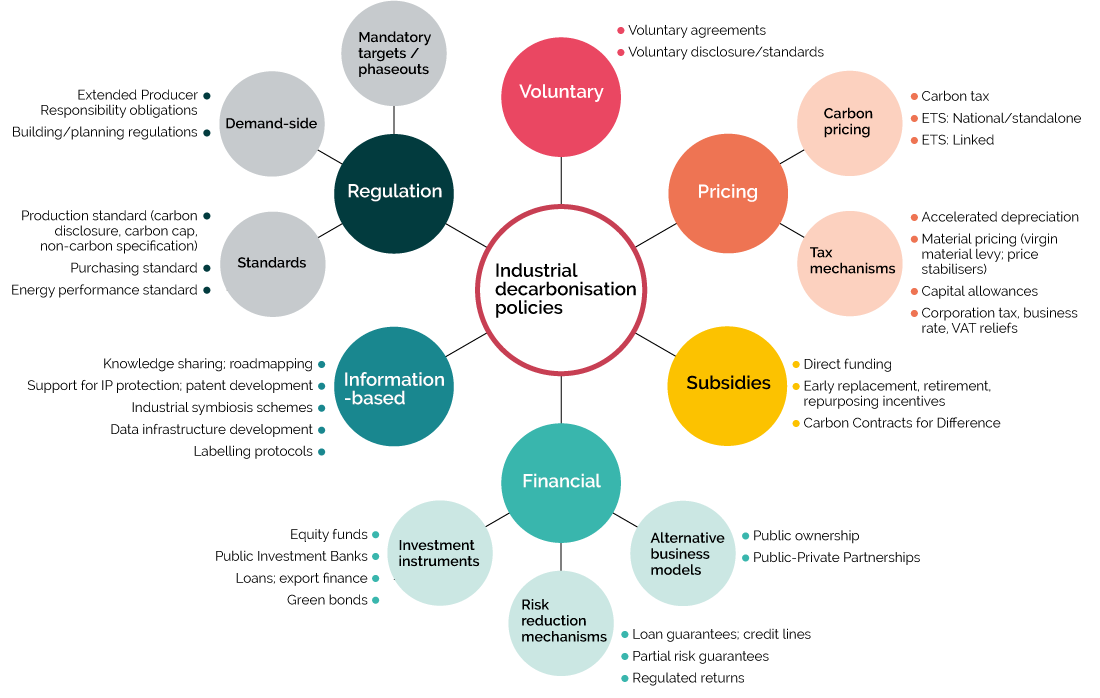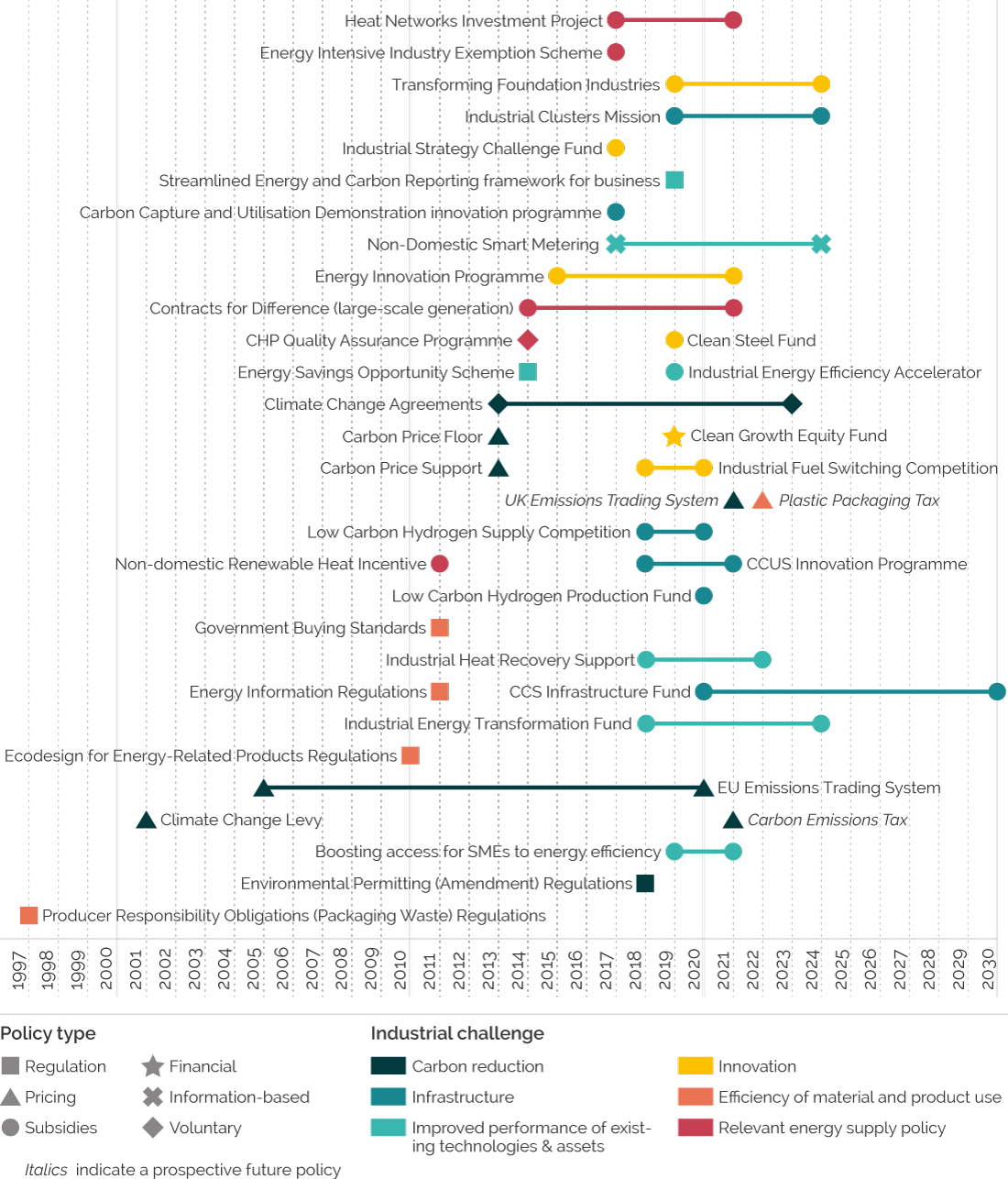Alice Garvey & Peter Taylor
About the report
UK industrial greenhouse gas (GHG) emissions must fall by more than 90% over the next 30 years to reach net zero GHG emissions targets by 2050.
Current industrial decarbonisation policies fall far short of what is required and so there is an urgent need to consider the design and implementation of new policies to deliver wide-scale and rapid reductions in industrial emissions. We propose that:
- policy must address multiple challenges to decarbonisation and go beyond an overarching carbon reduction mechanism.
- there is no ‘policy panacea’ and policy solutions need to be flexible and adapt over time.
- a number of principles should guide effective policy design (co-ordinated, lean, consistent, and phased).
Action to cut industrial GHG emissions must be taken quickly, and there are many uncertainties about the policy interventions that will work best. This research will help to inform decision makers about the policy areas that merit further consideration and scrutiny.
Go to Industrial decarbonisation policies for a UK net zero target for the full report.
Six key challenges for industrial decarbonisation
The report identifies that there are six challenges that industrial decarbonisation policy must address:
- Providing an overarching carbon reduction incentive (whether through carbon pricing, subsidies or regulation) and incorporating appropriate mechanisms to address carbon leakage.
- Deploying and coordinating infrastructure with industrial applications, for instance carbon capture, utilisation and storage (CCUS) networks and hydrogen pipelines, whilst encouraging integration and clustering where appropriate.
- Improving the energy performance of existing assets, technologies and processes, by encouraging early upgrade, refurbishment or even retirement where the net mitigation benefit would be highest.
- Incentivising innovation by supporting research across the commercialisation stages, and stimulating investment in demonstration and deployment.
- Improving the efficiency of material and product use, acting on the demand-side and creating markets for low-carbon goods and services.
- Creating ‘enabling policies’ with a socioeconomic focus that would support long-term industrial strategy, for instance skills, (re)training investment, and generating low-carbon manufacturing jobs across the supply chain in the sectors and regions in which they are most needed.
Policy principles
Though there are clearly no policy ‘panaceas’ in the available policy mechanisms and it would be difficult to pick a ‘policy winner’. The report outlines a series of policy ‘principles’ for effective industrial decarbonisation policy:
Developing policy ‘packages’: an effective approach could be in the use of policy ‘packages’, which link overarching carbon policies with complementary policies addressing each of the industrial decarbonisation challenges identified. This would create a strategic approach, optimising the synergies between policies and reducing their negative spill-over effects.
Providing clear and consistent policy signals: communicating the long-term design of policies with industry was identified as particularly important to allow for planning and adaptation. This also promotes certainty in the long-run policy signal, creating confidence to invest in low-carbon technologies with large upfront capital costs.
Streamlining policy: policies should deliver the required mitigation outcome in as lean a way as possible, without excessively ‘layering’ policy burden or creating inefficiency in the incentive or penalty. This would require cumulative policy impact to be assessed when evaluating any new policies, and how any additional measures would contribute to overall policy burden and cost.
Policy packages
The report identifies the need for the Government to adopt a co-ordinated approach, based on the implementation of ‘policy packages’, a group of policy instruments which work together strategically to drive decarbonisation.
Such a package would be comprised of an overarching carbon reduction mechanism (for instance pricing, subsidies, or regulatory tools such as standards), alongside complementary policies addressing key areas where action is needed and, importantly, mitigating any negative impacts on the competitiveness of UK industry.
The research identified a ‘typology’ of future policy options that could be considered to close the policy gap for industrial decarbonisation (Figure 1). Ultimately it was clear that the effectiveness of any given policy will be dependent on its specific design, which is why it is so important that Government announcements of funding are accompanied by a clear sense of the delivery mechanisms and policy tools which will be used to achieve the desired outcome.

Rapid policy response is essential for net zero
There are many uncertainties in planning future industrial decarbonisation policy in the current political and economic environment. This report is only able to provide an initial evidence base to inform such policy development and more detailed work will be needed to inform policy choices, not least on the impact of particular policies on specific industrial sectors.
However, the urgency of the climate crisis and the need for industrial emissions reductions to be accelerated to meet the UK’s net zero target demands a rapid policy response. We do not have the luxury of waiting while we design the perfect policy approach; action is needed now and we hope that this report can provide some guidance towards creating a clean and competitive future for UK industry.

Full report
Figure 1: Industrial decarbonisation policies are featured at the centre of a cluster of themes. Theme on regulation has sub-themes of: Mandatory targets / phaseouts, Demand-side which includes Extended Producer Responsibility obligations & Building / planning regulations and Standards which includes Production standard (carbon disclosure, cap, non-carbon specification), purchasing standard & Energy performance standard. The voluntary theme covers voluntary agreements and voluntary disclosure standards. The pricing theme includes sub-themes on carbon-pricing which covers Carbon tax, ETS: National / standalone & ETS: Linked, and tax mechanisms which covers Accelerated depreciation, Material pricing (virgin material levy; price stabilisers), Capital allowances and Corporation tax, business rate, VAT reliefs. The subsidies theme covers Direct funding, Early replacement, retirement, repurposing incentives & Carbon Contracts for Difference. The theme on financial includes sub-themes Alternative business models which focuses on Public ownership & Public-Private Partnerships, Risk reduction mechanisms which covers Loan guarantees; credit lines, Partial risk guarantees & Regulated returns, and Investment instruments which covers Equity funds, Public Investment Banks, Loans; export finance and Green bonds. The information-based theme covers Knowledge sharing; roadmapping, support for IP protection; patent development, Industrial symbiosis schemes, Data infrastructure development & Labelling protocols.
Figure 2: Timeline for current and prospective industrial decarbonisation policies: Carbon reduction challenge: 2013–2023: Climate Change Agreements (policy type: voluntary), 2013: Carbon Price Floor (policy type: pricing), 2013: Carbon Price Support (policy type: pricing), 2001: Climate Change Levy (policy type: pricing), 2005–2020: EU Emissions Trading System (policy type: pricing), 2018: Environmental Permitting (Amendment) Regulations (policy type: regulation), Prospective future policy – 2021: Carbon Emissions Tax (policy type: pricing), Prospective future policy – 2021: UK Emissions Trading System (policy type: pricing). Infrastructure challenge: 2019–2024: Industrial Clusters Mission (policy type: subsidies), 2017: Carbon Capture and Utilisation Demonstration innovation programme (policy type: subsidies), 2018–2020: Low Carbon Hydrogen Supply Competition (policy type: subsidies), 2018–2021: CCUS Innovation Programme (policy type: subsidies), 2020: Low Carbon Hydrogen Production Fund (policy type: subsidies), 2020–2030: CCS Infrastructure Fund (policy type: subsidies). Improved performance of existing technologies & assets challenge: 2019: Streamlined Energy and Carbon Reporting framework for business (policy type: regulation), 2017–2024: Non-Domestic Smart Metering (policy type: information-based), 2019: Industrial Energy Efficiency Accelerator (policy type: subsidies), 2014: Energy Savings Opportunity Scheme (policy type: regulation), 2018–2022: Industrial Heat Recovery Support (policy type: subsidies), 2018–2024: Industrial Energy Transformation Fund (policy type: subsidies), 2019–2021: Boosting access for SMEs to energy efficiency (policy type: subsidies). Innovation challenge: 2019–2024: Transforming Foundation Industries (policy type: subsidies), 2017: Industrial Strategy Challenge Fund (policy type: subsidies), 2015–2021: Energy Innovation Programme (policy type: subsidies), 2019: Clean Steel Fund (policy type: subsidies), 2019: Clean Growth Equity Fund (policy type: financial), 2018–2020: Industrial Fuel Switching Competition (policy type: subsidies). Efficiency of material and product use challenge: 2011: Government Buying Standards (policy type: regulation), 2011: Energy Information Regulations (policy type: regulation), 2010: Ecodesign for Energy-Related Products Regulations (policy type: regulation), 1997: Producer Responsibility Obligations (Packaging Waste) Regulations (policy type: regulation), Prospective future policy – 2022: Plastic Packaging Tax (policy type: pricing). Relevant energy supply challenge: 2017: Energy Intensive Industry Exemption Scheme (policy type: subsidies), 2014–2021: Contracts for Difference (large-scale generation) (policy type: subsidies), 2014: CHP Quality Assurance Programme (policy type: voluntary), 2011: Non-domestic Renewable Heat Incentive (policy type: subsidies).
Publication details
Garvey, A. and Taylor, P. 2020. Briefing: Industrial decarbonisation policies for a UK net zero target. CREDS Policy brief 014. Centre for Research into Energy Demand Solutions, Oxford.
Banner photo credit: Alireza Attari on Unsplash
